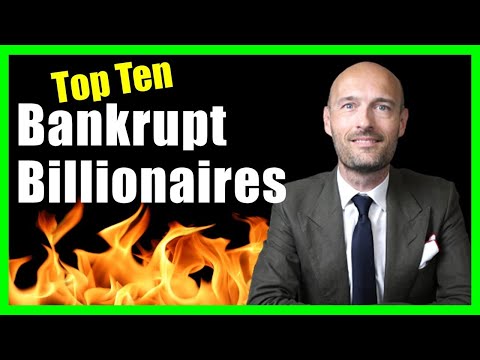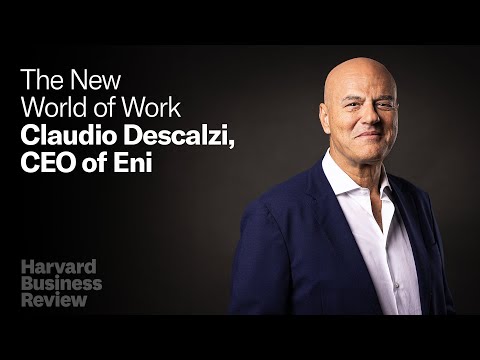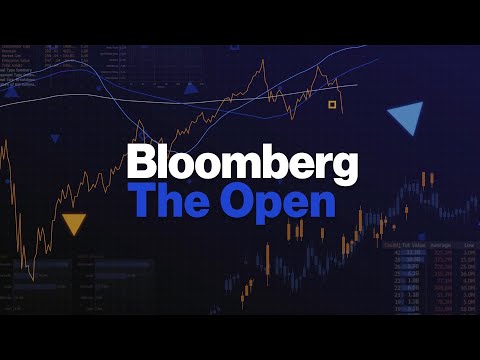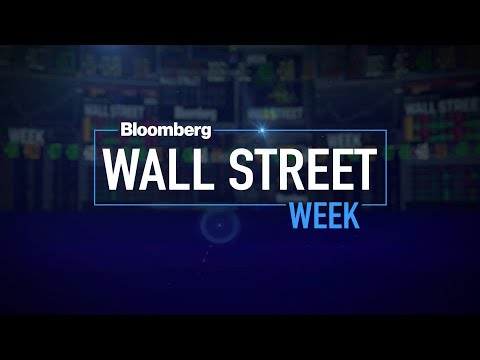Billionaires Who Lost Everything

This video was made in partnership with The Daily Upside — a totally free and very high-quality finance and investing newsletter that unpacks insightful and engaging stories which can be read in just five minutes each morning. According to Forbes Magazine there are 2,755 billionaires in the world today. The top five industries where they made their money are Finance, Technology, Manufacturing, Retail and Healthcare. It is rare to become a billionaire, but even more unusual to reach that level and then lose everything, but it is not unheard of.
Today we’ll look at ten one-time billionaires who later went bankrupt, and one whose net worth fell from eight billion dollars to two million dollars. Some of the people on this list lost their money through unfortunate investments, some through engaging in criminal activity. One gained her billions through divorce and then squandered it all, and one just gave it all away. Ok, first up we have Anil Ambani. Anil Ambani’s father died without leaving a will in 2002 with a net worth of $3 billion dollars.
A feud erupted between Anil and his brother Mukesh over who would run the family business, their mother finally stepped in splitting the family-owned businesses between the two brothers. By 2008, Anil was listed by Forbes as the sixth richest person in the world with a net worth of $42 billion. His fortunes began their decline in 2011 after a number of corruption scandals. Anil gained notoriety as one of the fastest destroyers of shareholder wealth in the last hundred years as his companies declined in value by more than 90% since their formation. In 2019, Anil was held in contempt of court for not paying the debt that his company owed to Swedish telecoms firm Ericsson that he had personally guaranteed. The court gave him a month to come up with the money otherwise he would go to jail.
He was rescued by his older brother, Mukesh who by that point was the wealthiest man in Asia and is one of the ten wealthiest people in the world today with a net worth of $72 billion dollars. In February 2020, Anil was locked in a legal battle with three Chinese banks. He was asked to set aside $100 million by the court which led him to announce that his net worth had fallen below zero once his liabilities were taken into account. The dispute still rages on with the UK court ordering him to pay the three Chinese banks $716 million. Next up is Jesse Livermore, an American stock trader who became famous in the 1920’s and is one of the pioneers of day trading. The main character in Reminiscences of a Stock Operator – one of the books I’ve recommended that all traders read was based on Jesse Livermore.
Livermore was reputed to have made a million dollars in a day with a short position in the panic of 1907. He then flipped to the long side tripling his money when the market rebounded. In early 1929, he amassed a huge short position in stocks, using more than 100 stockbrokers to hide what he was doing. In the 1929 crash, he made over $100 million (the equivalent of $1.5 billion today).
The press called him “The Great Bear of Wall Street" and blamed him for causing the crash. He received numerous death threats and had to hire an armed bodyguard. At one time, he was one of the richest people in the world, but over his volatile career he filed for bankruptcy three times. By 1939 he was in debt and trying to make a living selling a technical analysis system. In 1940 at the age of 63 Livermore shot himself dead in the cloakroom of The Sherry-Netherland hotel in Manhattan.
At the time of his suicide, he had liabilities greater than his assets. Some regard Livermore as the greatest trader who ever lived, while others see him as a cautionary tale about the risks of extreme leverage. Before we get to number three let me quickly tell you about the sponsor of today’s video.
The Daily Upside is a free newsletter written by a team of former investment bankers, journalists, and scholars. After reading the newsletter for the last few months, I can really recommend it. A lot of news sources just curate the big headlines, but The Daily Upside goes a level deeper, teasing out the insights that matter, and they surface stories that I don’t see elsewhere. If you’ve gotten tired of news outlets regurgitating headlines, The Daily Upside is your solution. They strike that elusive balance between gravitas and wit.
The other day they had apiece on how Robinhood’s free stock gimmick is costing companies millions of dollars in fees to print proxy materials. After reading that story, I was even compelled to make a YouTube short explaining it to my audience. Whether you’re a financial professional like me or looking for a better source of business news, The Daily Upside will help. It’s completely free to sign-up and read, and as a career investor I can’t recommend it enough. Sign up using the link in the description.
OK, so next up we have Bill Hwang - Before losing his $30 billion fortune, Bill was the greatest trader you’d never heard of. He began his career working for Julian Robertson’s at Tiger Management, one of the best performing hedge funds in history. He then started his own fund called Tiger Asia Management which went on to become one of the biggest Asia-focused hedge funds.
In 2012, he was accused of insider trading in Chinese bank stocks, he plead guilty and paid a $44 million fine to settle the case. He then wound up his fund and started a family office - Archegos in 2013 to invest his $200million in savings. Over an eight-year period he managed to turn that $200 million into a fortune of between twenty and thirty billion dollars. He was probably the most profitable trader in the world over this period of time. In two short days in late March 2021, all of his wealth and more was wiped out. Investment Banks had provided billions of dollars in leverage, allowing him to make massive bets.
His positions were extremely concentrated into a few highly correlated themes, on top of this certain single stocks made up between 10 and 20 percent of his portfolio. It looks like his approach involved taking a large position in a stock and then when its price rose, he would use those profits to borrow more money from his brokers to buy more of the stock driving it up further. When Viacom CBS began to fall in March, he received a margin call from his brokers that he could not meet. The brokers raced to dump the stocks, wiping out Bill, and causing huge losses at the slower moving banks like Credit Suisse and Nomura. OK, next on the list is Elizabeth Holmes who once made the cover of Forbes Magazine, listed as the youngest self-made billionaire in the world. She was the founder of Theranos, a blood testing startup which was valued at $9 billion at its peak, and she owned half of the company.
While it was a medical equipment (or testing) company, it was based in Silicon Valley. Holmes had (of course) dropped out of Stanford University after just two semesters and she dressed like Steve Jobs, so Theranos was viewed as a tech startup. Amusingly she insisted that the air conditioning be kept at 60 degrees in the offices, which made wearing a black turtleneck more comfortable in the warm California weather. John Carreyrou, a journalist at The Wall Street Journal first broke the story that the whole company was an elaborate fraud back in 2015 after receiving a tip that the technology did not work. His interest in Theranos was triggered by the claim that Holmes had invented such a ground-breaking medical technology after just two semesters of chemical engineering classes.
At first, Holmes denied the claims and threatened to sue. In 2018, she stepped down as CEO and was charged with criminal fraud, having misled investors and made false claims about the blood testing technology. Life-changing medical decisions were being made based upon the fabricated test results. The entire company had been built on a foundation of lies. Holmes now faces up to 20 years in prison.
Her trial begins this week. Next up is Eike Batista, who began his career selling insurance policies door to door in Germany. He moved to Brazil in the early 1980’s and at the age of 23 started a gold trading firm. A year and a half later, the company had earned US$6 million. From 1980 to 2000, he created $20 billion in value with the operation of nine mines in Brazil, Canada, and Chile. In 2011, All of Batista's companies were named with 3-letter combinations ending in the letter "X", which Batista believed was a symbol for the multiplication of wealth.
Batista was listed by Forbes magazine as the 8th richest person in the world and the richest person in Brazil. His wealth was estimated at $30billion. Batista’s business affairs began to unravel when his oil and gas exploration company, OGX, could not keep up with promised production, and investors pulled their money. In 2013, Bloomberg News reported his losses as "historic." The losses can be attributed largely to the downturn in the precious metals mining industry, as well as a catastrophic collapse of the oil and gas exploration company. Other economic issues and management decisions factored in as well.
Bloomberg News described it as a "Perfect Storm." By 2015 his net worth was negative, having fallen to more than $1 billion in debt. In 2017 Batista was arrested and jailed after being accused of paying bribes, later that year he was fined for insider trading. His legal troubles continued in 2018, when he was found guilty of bribery and sentenced to 30 years in prison. It is difficult to know what to make of some of these charges, as the Brazilian judge presiding over the insider trading charges was seen driving a Porsche belonging to Batista that had been seized by the court.
The judge claimed that the police had no other place to park it. OK, I’m sure you have all heard of Bernie Madoff, our next fallen billionaire. For decades, Madoff enjoyed an image as a self-made financial wizard whose trading skills defied market fluctuations. A former chairman of the Nasdaq, he attracted a devoted legion of investment clients from Florida retirees to celebrities. In 2008 his investment advisory business was exposed as a huge Ponzi scheme. It is believed to be the biggest fraud in Wall Street history.
He became so hated that he wore a bullet proof vest to court. Entirely apart from the Ponzi scheme, Madoff built a market-making firm that at one point was worth $3billion. Bernie Madoff was a pioneer of the payment for order flow business model that Robinhood has made famous in the last year. By paying for order flow, Bernie siphoned around 10 percent of the volume of trading on the New York Stock Exchange away from the specialist firms that dominated the Big Board's floor, creating what was known as a "third market". At the time of his arrest, fake account statements were telling clients they had holdings worth $60billion.
Over the years, court-appointed trustees unwound the assets and recovered around $14 billion of an estimated $17.5 billion that investors had originally put into Madoff’s scheme. Madoff pleaded guilty in March 2009 to securities fraud and other charges, saying he was “deeply sorry and ashamed.” Allen Stanford is next on our list. Though Allen is not as well-known as Bernie Madoff, he gained and lost his fortune the exact same way — a Ponzi scheme.
He defrauded about 18,000 people, out of the savings they put in his Bank - Stanford International Bank. At his peak in 2008, he was worth an estimated $2.2 billion. Over a three-year period, he spent over $100 million on aircraft, which included helicopters and private jets. He even spent $12 million lengthening his yacht by just 6 feet. He was knighted by the Antiguan government in 2006, but following his arrest and trial, his knighthood was stripped.
There is no record as to whether he wears a suit of armor or carries a sword in prison. (I’m sure there are rules about that) Stanford’s marketing materials claimed that the investors' Certificates of Deposit were backed by safe, secure investments. These allegedly low-risk investments paid between 11.5% and 16.5% (which is well above what investors should expect from low-risk investments) The bank claimed to be able to pay these above-market rates because it was in a low-tax haven and maintained minimal overhead. Other than the planes, boat enlargement surgery – cricket sponsorships and things like that… The scheme was discovered in 2009 and in 2012, Stanford was convicted of orchestrating a 20-year investment fraud scheme in which he misappropriated $7 billion to finance his personal businesses and lifestyle. He was sentenced to 110 years in prison.
The court imposed a personal judgment of $5.9 billion, which is an ongoing obligation for Stanford to pay back criminal proceeds. Next up we have Sean Quinn, the epitome of the self-made businessman. He famously built an international empire out of a hole he dug on his father's small farm.
At the age of fourteen, Quinn borrowed £100, dug a hole on his father’s 23-acre farm, started extracting gravel, washing it and selling it to local builders. Soon dubbed the 'Mighty Quinn', he carved out a reputation as a plain-living but fearless outsider who took on big monopolies and won. He took on the huge Cement Roadstone Holdings in Ireland, who had the cement and gravel market sewn up. His attention later switched to insurance, glass, plastics and radiators with the simple formula of taking on fearsome monopolies and undercutting their prices. By 2008 he was the richest man in Ireland with a net worth of $6bil before his business empire collapsed. In 2007 right before the financial crisis, he bought a 5% stake in Anglo Irish bank, a commercial bank that was very big in property lending in Ireland.
A country that was at the peak of a huge property bubble. As the price of Anglo fell Quinn started doubling down, buying contracts for difference on Anglo shares. These are a bet on the share price rising, if it does, you get paid the increase. If the price falls, you take the hit. As the price of Anglo fell, he took on enormous loans from Anglo so that he could hold on to his position. In total, Quinn would borrow around 3 billion dollars from Anglo just to pay the losses on their shares.
Quinn had to sign over the ownership in his profitable businesses to get these loans. Most of his other businesses were hit by the property bubble bursting too. Anglo Irish Bank was eventually bailed out by the Irish Government and Quinn’s shareholdings became worthless. In 2011 when Anglo was being wound up, the administrators tried to collect the money he had borrowed to buy shares and Quinn was forced to declare bankruptcy.
In 2012, Quinn was jailed for three months for contempt of court, accused of asset stripping just before losing control of his companies. Today he lives with his wife and family in County Cavan just down the road from his birthplace. Next up we have Jocelyn Wildenstein, who became a billionaire after receiving a $2.5 billion divorce settlement in 1999 from her art dealer ex-husband. Wildenstein was heavily featured in tabloids for her legendary spending habits and her extensive cosmetic surgeries that landed her with the nickname “Catwoman.” I should point out that she claims to have had no plastic surgery… Who Knows… She is the only billionaire on this list who lost her entire fortune by simply spending it.
In one story, she wrote a bad check for some very expensive jewelry which she then managed to lose before the jeweler got around to demanding it back. She told reporters her net worth dropped after several pieces of art in her trust were found to be forged or worth much less than expected. She also faced several lawsuits and foreclosures.
In 2018, Wildenstein filed for bankruptcy, claiming that she had no money left. It is quite amazing to have spent 2.5 billion dollars over nineteen years and have nothing to show for it –maybe she should check under the cushions on her couch for that lost piece of jewelry.
Our next story is quite a sad one, the story of Adolf Merckle - one of Germany’s most powerful industrialists who built his family’s small pharmaceutical company into a 120-firm conglomerate. He was known as a modest man who would bicycle to work every day. By 2007 he had built up a net worth of more than $9bn. In the 2000’s a very popular hedge fund strategy involved finding two financial securities which should have a relationship to each other - such as the preferred shares and the ordinary shares of a given company. If they got out of whack with each other (one going up while the other fell) a trading opportunity might exist. Investors would buy the relatively underpriced one and hedge the position by selling the overpriced security short.
The idea is that the market would eventually come to its senses and the prices would converge. A few hedge funds made a lot of money in 2001 when SAP chose to retire its preference shares, swapping them for ordinary shares to tidy up their capital structure. The preferred shares were trading at a 20 percent premium, so traders made huge profits when the two securities converged in price.
When other traders saw this happen, they began searching for similar situations so that they could do the same and all found Volkswagen, where the preference shares traded at a significant discount to the ordinaries. Merkle, along with a lot of hedge funds traded this spread - long the preferred shares and short the ordinaries. In October 2008, Porsche revealed that it had gained control of 74% of Volkswagen’s voting shares.
It was well known that The State of Lower Saxony owned 20 percent of the shares and would not sell, which meant that the shares available to buy on the open market had suddenly dropped to just under 6 percent of the float. Twelve per cent of the shares outstanding had been sold short, so there was no way for every short seller to close out their position. In other words, half the room were going to be left in a burning building with no way out.
A panicked dash for the exit began. This was one of the most extreme short squeezes in Wall Street History. In the midst of the great financial crisis, Volkswagen, briefly became the biggest company in the world. Yes, Volkswagen was even bigger than Tesla. Merckle lost around half a billion in the short squeeze, in addition the credit crunch hit his corporate empire hard. When chided for his losses, he argued that it was taking such risks that enabled him to build his empire and create hundreds of thousands of jobs in the first place.
Crushed by watching his life's work slip through his fingers, Adolf Merckle, threw himself under a speeding train in January 2009. At the time of his death, his investment company owed banks billions of euros. Our last billionaire on the list is Chuck Feeney, who co-founded the airport retailer “Duty Free Shoppers” in 1960, later launching the private equity firm General Atlantic. He amassed a net worth of around eight billion dollars while living a life of monk-like frugality. His goal was to give virtually all his money away over the last 40 years of his life. He pioneered the idea of “Giving While Living” - spending most of your fortune on big, hands-on charity bets instead of funding a foundation upon your death.
He figured that if you can't take it with you—why not give it all away and have control of where it goes and see the impact with your own eyes. While many philanthropists hire an army of publicists to trumpet their donations, Feeney went to great lengths to keep his gifts secret. In September 2020, Feeney closed down his charity, having given away all of his wealth, less retirement savings of around $2 million dollars for him and his wife. Don’t forget to check out our sponsor The Daily Upside, by clicking the link in the description.
It’s a great newsletter I can firmly recommend. YouTube has predicted that you’ll want to watch this video next. Let’s see if they are right!
2021-09-03 16:11


